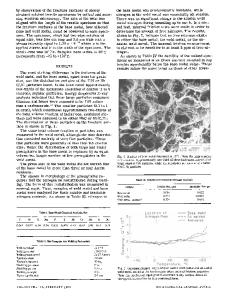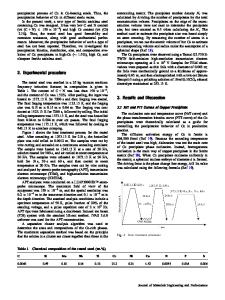Characteristics and Modification of Non-metallic Inclusions in Titanium-Stabilized AISI 409 Ferritic Stainless Steel
- PDF / 3,155,633 Bytes
- 19 Pages / 593.972 x 792 pts Page_size
- 121 Downloads / 330 Views
DUCTION
TITANIUM-STABILIZED stainless steels are well known among stainless steel manufacturers for all the wrong reasons. Due to the tendency of titanium to form solubility products, i.e., titanium oxides and nitrides prior to solidification of the steel, submerged entry nozzle (SEN) clogging is a well-known problem, which leads to poor surface quality.[1–5] TiN also promotes the nucleation of d-ferrite leading to subsequent solidification in the SEN.[6] The presence of other deoxidants such as aluminum and magnesium yields complex multiphase non-metallic inclusions, which in itself can result in SEN clogging.[6] These inclusions enhance the SEN clogging ability of titanium by acting as heterogeneous nucleation sites for oxides and nitrides, forming complex inclusions that are extremely harmful to the final surface, mechanical properties, and formability of the steel. SEN clogging has a negative impact on production efficiency and yield, and increases consumption of casting consumables, ultimately being a very costly experience for the manufacturer. During hot and cold rolling, clusters of non-metallic inclusions can also be brought to the surface resulting in line and/or lamination-type defects. This leads to degradation or scrapping of the steel with all the value adding lost. The DIRK KRUGER is with the Department of Materials Science and Metallurgical Engineering, Centre for Pyrometallurgy, University of Pretoria, Pretoria, 0002, South Africa and also with the Columbus Stainless, Old Hendrina Road, Middelburg, 1055, Mpumalanga, South Africa. Contact e-mail: [email protected] ANDRIE GARBERS-CRAIG is with the Department of Materials Science and Metallurgical Engineering, Centre for Pyrometallurgy, University of Pretoria. Manuscript submitted February 19, 2016. METALLURGICAL AND MATERIALS TRANSACTIONS B
material can also crack during deformation or spinning manufacturing when the exhaust component is being manufactured at the customer, resulting in claims against the supplier. A summary of the different inclusions found in other studies conducted on titanium-stabilized stainless steels is shown in Table I.[1–5,7] These inclusions are usually dual-phase structures consisting of a deoxidation product or entrapped slag product, usually MgOÆAl2O3 (MA) spinel, which acts as a heterogeneous nucleation site and/or bonding phase for titanium solubility products such as TiN or TixOy. Strategies to prevent their formation include preventing the formation of both phases. An example of a MA spinel acting as a heterogeneous nucleation site is shown in Figure 1. Various researchers studied nucleation sites (complex deoxidation products) such as MA spinels and attempted to modify their compositions to make them less prone to act as nucleation sites, or to reduce their formation altogether by controlling steel and slag compositions.[8–14] Some researchers believe magnesium within MA spinel inclusions originate exclusively from the ladle slag,[15] while others are convinced that it comes from the refractory bricks in the AO
Data Loading...










